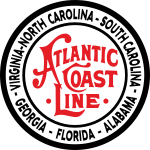
Back Atlantic Coast Line Railroad French アトランティック・コースト・ライン鉄道 Japanese Atlantic Coast Line Railroad Russian
 | |
 ACL system map, c. 1914 | |
| Overview | |
|---|---|
| Headquarters | Wilmington, North Carolina (1900–1960) Atlantic Coast Line Railroad Building, 500 Water Street, Jacksonville, Florida (1960–1967) |
| Reporting mark | ACL |
| Locale | Alabama Florida Georgia North Carolina South Carolina Virginia |
| Dates of operation | 1900–1967 |
| Successor | Seaboard Coast Line Railroad |
| Technical | |
| Track gauge | 4 ft 8+1⁄2 in (1,435 mm) standard gauge |
| Length | 5,155 miles (8,296 kilometres)[1] |
The Atlantic Coast Line Railroad (reporting mark ACL) was a United States Class I railroad formed in 1900, though predecessor railroads had used the ACL brand since 1871. In 1967, it merged with long-time rival Seaboard Air Line Railroad to form the Seaboard Coast Line Railroad. Much of the original ACL network has been part of CSX Transportation since 1986.
The Atlantic Coast Line served the Southeast, with a concentration of lines in Florida. Numerous named passenger trains were operated by the railroad for Florida-bound tourists, with the Atlantic Coast Line contributing significantly to Florida's economic development in the first half of the 20th century.[2]
At the end of 1925, ACL operated 4,924 miles of road, not including its flock of subsidiaries; after some merging, mileage at the end of 1960 was 5,570 not including A&WP, CN&L, East Carolina, Georgia, Rockingham, and V&CS. In 1960, ACL reported 10,623 million net ton-miles of revenue freight and 490 million passenger-miles.[citation needed]
- ^ Drury, George H. (1994). The Historical Guide to North American Railroads: Histories, Figures, and Features of more than 160 Railroads Abandoned or Merged since 1930. Waukesha, Wisconsin: Kalmbach Publishing. pp. 28–32. ISBN 978-0-89024-072-4.
- ^ Dickens, Bethany (June 5, 2014). "Episode 17 Travel Dining". A History of Central Florida (Podcast). Retrieved January 24, 2016.
© MMXXIII Rich X Search. We shall prevail. All rights reserved. Rich X Search